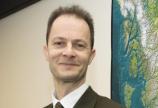New research chair will be BC’s eye in the sky
- Valerie Shore

University of Victoria geologist Dr. Benoit Rivard and his team will be keeping a very close watch on BC’s natural resources in the coming years.
As the new BC Leadership Chair in Hyperspectral Remote Sensing, Rivard is investigating new ways to use advanced remote sensing techniques to protect and manage the province’s natural resources. The chair was announced last month and is the first in its field in Canada.
The $4.5-million chair is funded by a $2.25-million investment from the province’s Leading Edge Endowment Fund (LEEF) and matching funds from UVic and the University of Victoria Foundation.
Rivard is former director of the Centre for Earth Observation Science at the University of Alberta and a leader in interpreting hyperspectral data. The chair is based in UVic’s Department of Geography.
“Dr. Rivard’s appointment builds on our already considerable strengths in hyperspectral remote sensing,“ says UVic president David Turpin. “Thanks to the Leading Edge Endowment Fund and the generosity of matching donors, this program will be a focal point for research on the application of hyperspectral imaging technology to BC’s natural resource challenges and opportunities.”
Remote sensing is the science of obtaining information on an object, area or phenomenon from a distance, typically by using aircraft, satellites, buoys or ships.
Hyperspectral imaging collects and measures the visible light reflected from surface features such as rocks, trees and water, as well as the non-visible energy they emit. It provides much more detailed imagery than conventional remote sensing systems.
UVic scientists use ground-based, airborne and satellite-based hyperspectral imaging systems to study the condition of targets such as water surfaces or vegetation canopies. This information is used for various applications, including mapping the health of coastal environments, determining the risk factor for forest fires and the extent of pine beetle infestation.
UVic is the only academic institution in Canada to have an airborne hyperspectral scanner, flown in partnership with Terra Remote Sensing in Sidney, BC. The scanner is being combined with other sensors—thermal scanners, digital cameras and a LiDAR scanning laser system—to address issues in resource exploration and management, and environmental monitoring. The platform is unique in Canada.
Rivard will work with government, industry and other university researchers to develop new hyperspectral techniques for resource exploration and environmental monitoring. He’ll also develop methods to find early signs of pests such as the mountain pine beetle.
“Once the trees show signs visible to our eyes, the beetles have already moved on,” he explains. “To take action, we need to detect an infestation while the trees are still green. This is one of many resource management areas where hyperspectral imaging has great potential.”
Rivard is also working on new hyperspectral methods for detecting a range of minerals and rock types and for estimating their abundance and distribution in a wide range of geological environments, including the Canadian North. This work has the potential to reduce field exploration costs for resource industries.
Under the LEEF program, the provincial government is establishing 20 leadership chairs to attract top researchers to BC and keep them here. This is UVic’s second LEEF chair. The first, in marine ecosystems and global change (held by Dr. Kim Juniper), was awarded in 2006.

